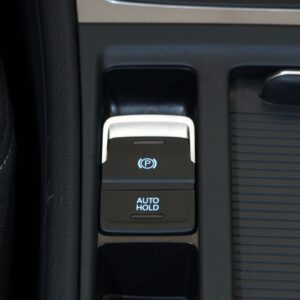There’s a lot to keep track of while driving, from gears, acceleration, and steering. If you drive a traditional vehicle, each of these systems rely on either hydraulic or mechanical technology to operate. However, there’s a relatively new way of operating these systems, one that has its roots in the aviation industry and is now gaining traction in the automotive world.
Drive-by-wire technology has the potential to revolutionize vehicles everywhere, and manufacturers are starting to implement this tech more and more in their vehicles. Using this type of technology can lead to better fuel efficiency, lighter car bodies, and safer roads. But what’s drive-by-wire technology all about? How does it work, and is it safe to use in its current state? Let’s find out.
What Is Drive-by-Wire in Cars?
So what does drive-by-wire mean? Drive-by-wire technology isn’t a singular piece of tech. Rather, it’s an electronic systems category that has a number of subsets. Drive-by-wire electronic systems either augment a vehicle’s traditional mechanical controls or replace them entirely. These newer systems rely on a series of sensors and computers to determine how and when to activate certain vehicular components, like when to engage the brakes and how much fuel to feed the engine.
When these electronic systems fuel the engine, activate brakes, and control steering, they make the traditional cables and hydraulic pressure controls connected to these systems obsolete. Airplanes have been using something similar in their fly-by-wire technology for years.
Drive-by-Wire Types
Drive-by-wire technology also goes by the terms “x-by-wire” and “by-wire.” This is because the category contains a number of subsets. Most drive-by-wire technology covers either the throttle, the brakes, or the steering. A full drive-by-wire system would eliminate a majority of the hydraulic and mechanical components, relying solely on electrical signals and sensors to engage the different systems.
Throttle-by-Wire
Drive-by-wire used to only refer to electronic throttle control, which is now known as throttle-by-wire or accelerate-by-wire. A set of redundant accelerator pedal position sensors detect exactly how far you push down on the gas pedal and send the information to the powertrain control module (PCM). The PCM relays this info to a motor connected to the butterfly valve in the throttle body, which engages the throttle accordingly. Another redundant set of throttle position sensors tracks the butterfly valve’s operation and relays this info back to the PCM, forming a classic computer feedback loop.
Brake-by-Wire
Brake-by-wire operates in a similar way to throttle-by-wire. A position sensor connects to the brake pedal and relays information to a brake control unit about how far you press the brake pedal. This determines how much pressure the system applies to the brakes, or in other words, how much deceleration you’re demanding from the system. The amount of deceleration is in line with how far you press on the brakes, and the system adjusts to use the mechanical brakes as needed.
In modern vehicles with brake-by-wire systems, the system also uses a pressure simulator to mimic the resistance of a traditional hydraulic brake system.

Steer-by-Wire
A traditional steering system is highly reliant on mechanical connections to operate. Rotating the steering wheel rotates a steering shaft, which connects to and turns a pinion, which then rotates the wheels. Power-steering vehicles have an additional electric motor to help you turn the wheel more easily.
On a steer-by-wire system, there’s no steering shaft at all. Like brake-by-wire and throttle-by-wire, drive-by-wire steering detects the position of the steering wheel using a sensor. From there, a controller receives the information and instructs a motor on the steering rack to turn the wheels accordingly. This motor is called a steering control actuator (SCA), and it also detects when the wheels experience force from the road surface. The SCA relays this information to an electric motor in the steering column, which provides haptic feedback to the driver that matches up with the road conditions.
Drive-by-Wire Benefits and Drawbacks
As you can imagine, removing tried and tested mechanical components from a vehicle and shifting to a more electronics-based system like drive-by-wire can be controversial. Drive-by-wire has benefits as well as drawbacks.
Benefits
Drive-by-wire systems are much lighter than traditional throttle, brake, and steering systems. Because they rely on fewer moving parts, they also tend to last longer before needing maintenance or service checks. Electric parts are also more operationally accurate than mechanical ones, so you can expect increased fuel efficiency and reduced emissions.
Drawbacks
Unfortunately, many drivers have concerns regarding drive-by-wire safety. The fact that by-wire systems rely so heavily on electronic components means that there’s a possibility they can fail, despite rigorous testing. Electronic malfunctions, especially in the system’s sensors and computers, are significantly more dangerous in drive-by-wire systems. Calculation errors from failing sensors mean the brakes won’t engage as they should or the steering might not respond as intended.
However, fly-by-wire systems have been a staple in aviation technology for decades now. This proves that it’s possible to create a safe, reliable system buttressed by rigorous testing and planning.
Drive-by-Wire Vehicles
While no full drive-by-wire vehicles exist, some manufacturers like General Motors and Mazda have created concept vehicles to showcase this technology. Tesla is at the forefront, pushing closer and closer to the full drive-by-wire experience and vying for autonomous use on the road.
Throttle-by-wire is the most prevalent by-wire system and can be found on a variety of different vehicles. Meanwhile, Mercedes and Toyota have both added brake-by-wire systems to their production models.
Now that you know what drive-by-wire is and how it works, you can decide if it’s a feature you’re eager to have in your next vehicle, or if it’s one you’d rather wait and see evolve over time. Either way, automotive technology is advancing, and drive-by-wire is one path to the future.
Any information provided on this Website is for informational purposes only and is not intended to replace consultation with a professional mechanic. The accuracy and timeliness of the information may change from the time of publication.






























